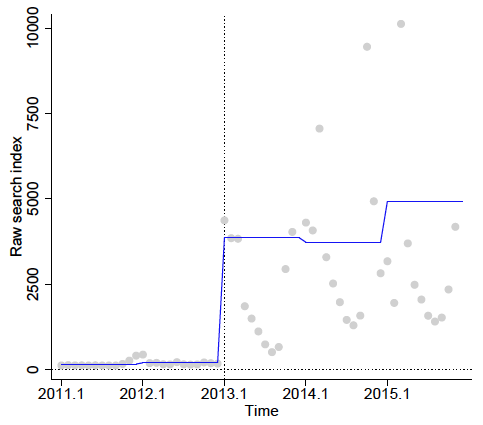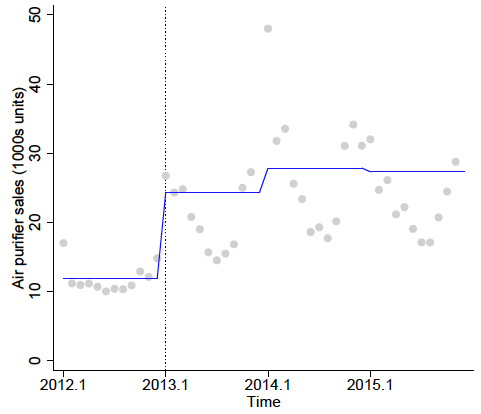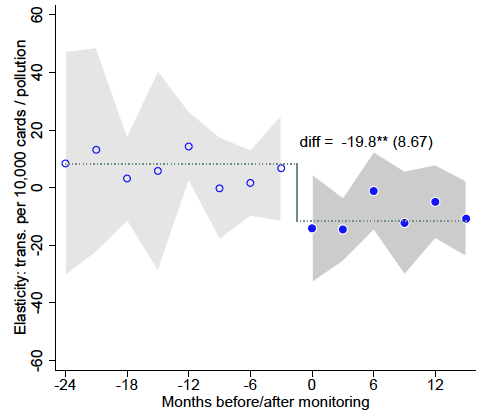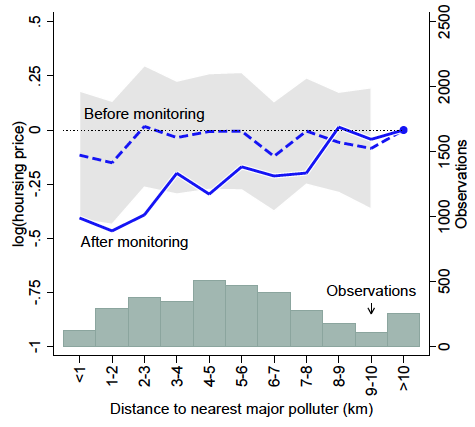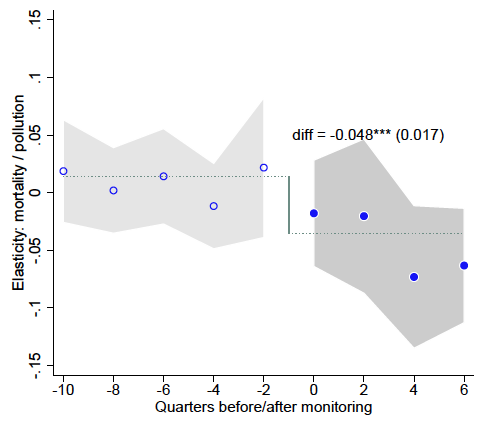Although air pollution has been a longstanding issue in China, public access to real-time daily pollution measures was practically absent prior to 2013. The Ministry of Environmental Protection has published the daily Air Pollution Index (API) for major cities since 2000, but the index, which was reported only after the fact, only partially reflected true air quality because it did not incorporate PM2.5, the major air pollutant in many Chinese cities (Greenstone et al. 2019). The lack of awareness of PM2.5 led to a widespread confusion between fog and smog among the public, where poor visibility due to high levels of PM2.5 was often characterised as fog rather than smog by both government agencies and the media.
The introduction of real-time PM2.5 monitoring and disclosure in December 2012 was a watershed moment in the history of China’s environmental regulations. The programme brought about a sharp and sudden change in the ability of average residents to access pollution information and drastically enhanced public awareness of the health impacts of PM2.5.
Our recent study (Barwick et al. 2019) documents the profound effect of this information programme by exploiting the most comprehensive database ever compiled on a rich set of outcomes – including social awareness, air quality measures from satellites, short- and long-run economic activities, and health outcomes – that cover the period before and after the information programme. We exploit the staggered introduction of the information programme across three waves of cities over the course of two years:
- The programme began in 74 major cities that represent the country’s key population and economic centres, such as the Beijing-Tianjin-Hebei Metropolitan Region and provincial capitals. Real-time readings on all major air pollutants were posted online and were ready for streaming by 31 December 2012.
- By 31 October 2013, the second wave was completed, adding 116 cities from the list of the 2007 Environmental Improvement Priority Cities and the National Environmental Protection Exemplary Cities, many of which neighbour first-wave cities.
- In the final wave, completed on 20 November 2014, the programme reached the remaining 177 cities.
The staggered roll-out allows us to implement an event-study design. This method estimates the causal effect of the information programme by identifying sharp changes in outcomes that occur exactly at the time of roll-out. To check design validity, we assess the parallel trends property through visualising trends in outcomes before the programme roll-out. We find flat and stable pre-trends, as shown in the figures below.
We first show that the information programme has transformed the landscape of public access to pollution information and dramatically increased households’ awareness about pollution issues. The frequency of air-pollution related articles in People’s Daily, the government’s official newspaper, rises from less than once per week to almost daily (Figure 1).
Figure 1 Changes in People’s Daily’s smog news mentions
The number of mobile phone apps released each year that stream air pollution data to users surges by 500%, four times faster than the growth of other apps (Figure 2).
Figure 2 Changes in pollution information access: Mobile phone apps
Immediately after the programme was launched, the term “smog” (“wu mai” in Chinese) became, for the first time, a buzzword in social media (Figure 3).
Figure 3 Changes in the Baidu ‘smog’ search index at the national level
These changes in access to information and public awareness triggered a cascade of short-run and long-run behavioural changes in household activities such as purchases of air purifiers, day-to-day shopping, and housing demand. In our short-run analysis, we show that within one year of the programme’s implementation in a city, purchases of air purifiers more than doubled and became highly correlated with the local pollution level (Figure 4).
Figure 4 Changes in pollution awareness: Air purifier sales in 50 cities
Linking outdoor purchase activities to local ambient air pollution, we further show that the information programme boosted pollution avoidance. The negative purchase–pollution elasticity of 3% is robust across a host of econometric specifications. As expected, the increase in pollution-avoiding behaviours is concentrated in plausibly ‘deferrable’ types of consumption, such as supermarket shopping, outdoor dining, and entertainment, rather than in ‘scheduled’ trips such as to pay pays, business-to-business wholesales, and cancer treatment sessions (Figure 5).
Figure 5 Changes in short-run avoidance: Weekly card transaction-pollution gradient
Our long-run analysis focuses on the effect of pollution information on the housing market. By leveraging geolocation information from the near-universe of new home sales in Beijing, we examine how the pollution information induced changes in the relationship between housing prices and local pollution levels, using two different research designs.
First, we employ the pixel-averaging technique (‘oversampling’) to enhance the original satellite pollution data’s spatial resolution from 10 x 10 km to 1 x 1 km. We estimate a home value–pollution elasticity of -0.6 to -0.8 post-disclosure. An increase in pollution by one standard deviation is associated with a reduction of between 4% an 6% in housing price. In contrast, the elasticity before the information programme is small and statistically insignificant (-0.10 to 0.09).
Second, we link China’s emission inventory database with business registries to identify the addresses of mega-polluters in Beijing – specifically, the 10% of facilities that account for 90% of total industrial air emissions. Following Currie et al. (2015), we estimate separate ‘distance gradient’ curves – expressing the home value as a function of proximity to the nearest major polluter – before and after the information programme. While there is no correlation between housing prices and proximity to polluters prior to the programme, we find that houses within three kilometres of a major polluter depreciate by 27% after the programme (Figure 6).
Figure 6 Changes in long-run capitalisation: Housing price versus polluter distance, Beijing
Our last set of empirical analyses examines changes in the mortality–pollution relationship as access to information improves. Using nationally representative mortality data from the Chinese Center for Disease Control and Prevention, we find a five percentage point reduction in the post-monitoring mortality–pollution elasticity.
The reduction is concentrated in cardio-respiratory causes (Figure 7) and is more precisely estimated among the age groups more vulnerable to pollution exposure. The impact is more pronounced in places that have a larger share of urban population, have more hospitals per capita, consume more electricity, and have higher mobile phone penetration. These patterns are remarkably similar to heterogeneous short-term avoidance responses uncovered using card-spending data, suggesting a plausible pathway in which effective avoidance of pollution can lead to beneficial health outcomes.
Figure 7 Changes in health outcomes: Quarterly mortality–pollution gradient
Combining our findings with existing estimates on the causal effect of pollution on mortality in China (e.g. Ebenstein et al. 2017), we find that access to pollution information has reduced premature deaths attributable to air pollution exposure by nearly 7% and has generated a health benefit that is equivalent to a 10 μg/m3-reduction in PM10. Based on recent estimates in the literature (Ito and Zhang 2018, Ashenfelter and Greenstone 2004, Murphy and Topel 2006), the associated annual benefits vary from 130 billion renminbi (using willingness-to-pay for clean air) to 520 billion renminbi (using age-adjusted value of statistical life).
By our calculations, these social benefits outweigh the costs of defensive investments (such as air purifier purchases), avoidance behaviour (such as forgone consumption), and deploying and maintaining the information programme by at least one order of magnitude, making the information programme among the most successful environmental policies in developing countries.
China’s experience offers an important lesson for other developing countries that are experiencing severe environmental challenges. The infrastructure for monitoring environmental quality and disclosing information is often inadequate in these countries. As income rises, the demand for environmental quality increases and households are better able to adapt to the changing environment.
Improving access to information can represent low-hanging fruit in the ongoing battle with environmental challenges. Providing real-time pollution monitoring data, combined with an effective dissemination infrastructure such as smartphones and the internet that are now commonly available among developing countries, could prove to be a powerful tool to help households mitigate the health damage from environmental pollution and to enhance the effectiveness of other environmental regulations.
References
Ashenfelter, O and M Greenstone (2004), “Estimating the value of a statistical life: The importance of omitted variables and publication bias”, American Economic Review 94(2): 454–60.
Barwick, P J, S Li, L Lin and E Zou (2019), “From fog to smog: The value of pollution information”, NBER Working Paper 26541.
Currie, J, L Davis, M Greenstone and R Walker (2015), “Environmental health risks and housing values: Evidence from 1,600 toxic plant openings and closings”, American Economic Review 105(2): 678–709.
Ebenstein, A, M Fan, M Greenstone, G He and M Zhou (2017), “New evidence on the impact of sustained exposure to air pollution on life expectancy from China’s Huai River policy”, Proceedings of the National Academy of Sciences 114: 10384–9.
Greenstone, M, G He, R Jia and T Liu (2019), “Can Technology Solve the Principal-Agent Problem? Evidence from Pollution Monitoring in China”, working paper.
Ito, K and S Zhang (2018), “Willingness to pay for clean air: Evidence from air purifier markets in China”, Journal of Political Economy, forthcoming.
Murphy, K M and R H Topel (2006), “The value of health and longevity”, Journal of Political Economy 114(5): 871–904.







